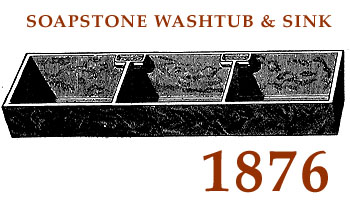AMONG the mineral productions the usefulness of which has for centuries remained unknown, and only recently has become to be appreciated, is undoubtedly soapstone, by mineralogists called steatite, and by chemists hydrated silicate of magnesia. The pure material is white, translucent, and looks like soap, while all the varieties have a. greasy feeling, whence the name soapstone. The ordinary variety has a bluish or greenish-gray appearance, which is caused by slight traces of foreign ingredients, and as these vary with the locality, so does the color of the soapstone. A beautiful variety is now quarried in New Hampshire, from whence at present blocks and slabs are sent to various cities, and are worked up in New York chiefly into wash-tubs and sink-basins, for which the material is most admirably adapted, being not only perfectly waterproof, but literally indestructible, so that by the use of it the utmost cleanliness, unattainable with wooden wash-tubs is secured.
Every housekeeper, servant, or head of a family who attends to the duty of looking after the condition of the various things to be used in keeping an orderly house, must have become convinced that the wooden stationary wash-tubs are a nuisance. After they have been in use for some time, they emit a most disagreeable odor, which no amount of care can prevent. The cause of this is a slow decay of the wood by the continual absorption of water. If not very well made, they will often leak, causing great annoyance, and requiring frequent repairs, involving a perpetual bill of expenses. If they are so well made as never to leak, they cost as much as soapstone tubs can now be furnished for, a fact which we can testify to from personal experience.
We do not hesitate, therefore, to recommend the introduction of soapstone stationery wash-tubs in all first-class new houses, and an exchange for the wooden ones, as soon as a renewal is required. Even if they do cost a little more than wooden tubs (which is not the case when the latter are as good as they can be made,) it would in any case be cheap in the end, as they are indestructible (even if the house burns down, being fire-proof as well as water-proof), so that while the best wooden tubs require to be renewed about every ten years, the soapstone tubs involve only one single outlay.
The way in which the slabs are put together so as to form the tub with waterproof joints, is as simple and ingenious as it is effective. The flat side is ploughed out to the thickness of the piece to be set in on edge, they are secured together with sunken bolts and nuts in the same way as a stair-rail, while the joint is made perfectly waterproof with a cement indestructible even by boiling water.
The qualities of soapstone are indeed most remarkable; it is never affected by water, even the hottest: the tubs never crack or leak, can be wiped perfectly dry, and are always clean and odorless. Neither acids nor alkalies affect the material, and for this reason soapstone mortars have been used by chemists from time immemorial. We have even used soapstone tabletops in order to have a material as little as possible susceptible to be attacked by the chemicals used, and we have no doubt that this material will in the course of time be applied to many scientific purposes.
For sinks they are far superior to iron, which is always rusty and dirty, while the charge for breakage of plates on soapstone is considerably less than it is on iron. Wooden sinks should never be allowed on sanitary grounds.
We are confident of expressing a correct opinion when we say that the general health, comfort, and quietude of a household is largely and directly promoted by the adoption of soapstone wash-tubs and sinks; and it is not surprising, therefore, that all who use them unite in their favorable testimony, and that at the late fair of the American Institute a medal was awarded to this useful improvement and display of articles manufactured of this material.
In regard to the latter we may mention that there are variously colored soapstones for the construction of ornamental tiling for floors and sidewalks. Beautiful specimens of this may be seen in a few churches; but thus far the material is not used as extensively for this purpose as it deserves, but no doubt that ultimately it will be largely employed.
The public is much indebted for the introduction of this useful material to Mr. F. 0. Munroe, of 107 West 25th Street, where fine specimens of work may be seen, and who deserves a reward for his energy and perseverance.

